Marc Weidenbaum's Blog, page 14
July 10, 2025
Disquiet Junto Project 0706: Tile One On

Each Thursday in the Disquiet Junto music community, a new compositional challenge is set before the group’s members, who then have five days to record and upload a track in response to the project instructions.
Membership in the Junto is open: just join and participate. (A SoundCloud account is helpful but not required.) There’s no pressure to do every project. The Junto is weekly so that you know it’s there, every Thursday through Monday, when your time and interest align.
Tracks are added to the SoundCloud playlist for the duration of the project. Additional (non-SoundCloud) tracks also generally appear in the lllllll.co discussion thread.
Disquiet Junto Project 0706: Tile One On
The Assignment: Make the most of your bathroom.
This week’s project has just one step: record something that makes use of the acoustics of your bathroom. (Or someone else’s bathroom.)
Tasks Upon Completion:
Label: Include “disquiet0706” (no spaces/quotes) in the name of your track.
Upload: Post your track to a public account (SoundCloud preferred but by no means required). It’s best to focus on one track, but if you post more than one, clarify which is the “main” rendition.
Share: Post your track and a description/explanation at https://llllllll.co/t/disquiet-junto-project-0706-tile-one-on/
Discuss: Listen to and comment on the other tracks.
Additional Details:
Length: The length is up to you. How long do you shower?
Deadline: Monday, July 14, 2025, 11:59pm (that is: just before midnight) wherever you are.
About: https://disquiet.com/junto/
Newsletter: https://juntoletter.disquiet.com/
License: It’s preferred (but not required) to set your track as downloadable and allowing for attributed remixing (i.e., an attribution Creative Commons license).
Please Include When Posting Your Track:
More on the 706th weekly Disquiet Junto project, Tile One On — The Assignment: Make the most of your bathroom — at https://disquiet.com/0706/.
July 9, 2025
Sentry
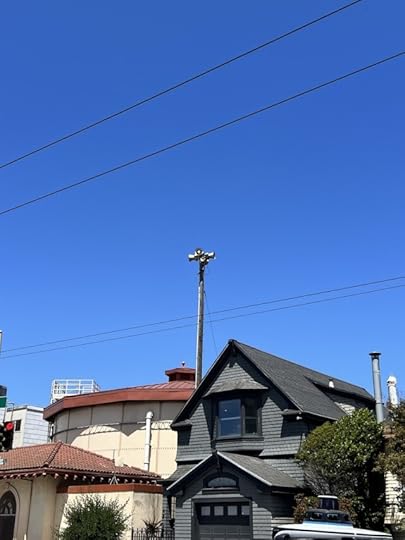
This sentry stands atop a hill in San Francisco. Not a sentry, really. One of the city’s many outdoor public warning system (OPWS) speakers. Except not speakers, really, either — because the speakers don’t function. They were turned off years ago in advance of being updated. Then the pandemic hit, and budgets got hit, and now the speakers are remnants of best laid plans. The recent floods in Texas are a reminder that as archaic as such systems may seem, they are an essential component of life — rural and urban alike. I’m hopeful the San Francisco OPWS will eventually get fixed, and that the Tuesday noon siren tests, which were silenced toward the end of 2019, will once again be part of our local soundscape.
July 8, 2025
“gl-i-iv-v-tched”
A simple drone and I IV V progression, both from electric guitar, the latter part glitched thanks to a somewhat chaotic LFO, the former frozen from a single opening chord, the combination done live in VCV Rack over lunch. Very simple, a lot of fun.
[image error]This setup has proved useful at the office. It’s an elegant way to get the guitar, via a simulated guitar amp cabinet, into the laptop:
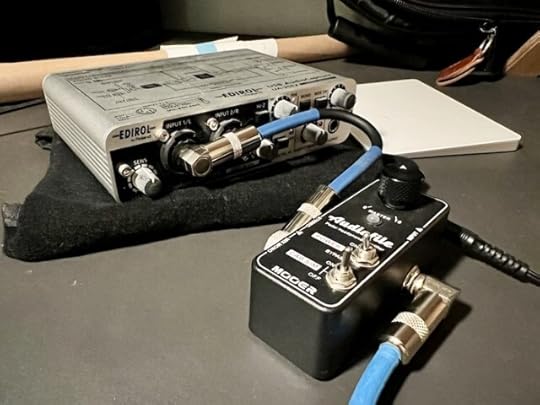
July 7, 2025
14 Miles Across San Francisco
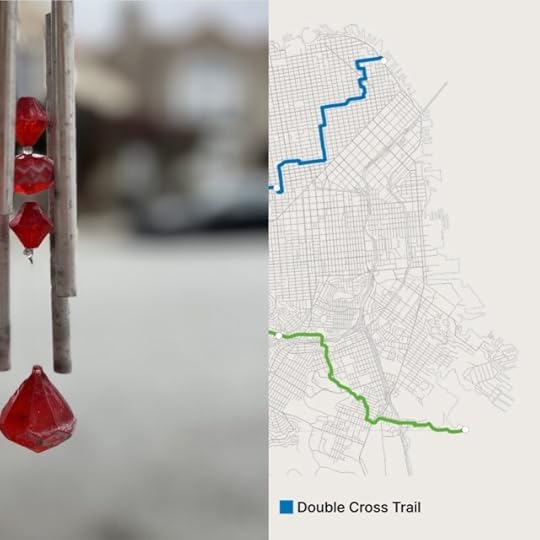
There’s little chance that Saturday didn’t amount to the longest continuous* walk I’ve undertaken, nearly 14 miles across San Francisco, from the southeast (Fort Funston, which had so many dogs walking their humans that you’d think you’d stepped into a chapter of Philip Pullman’s His Dark Materials) to the northwest (Pier 23, following a trail-ending descent of the twisty Greenwich steps).
This route is called the Double Cross Trail, and it’s a twin to the Crosstown Trail, the two meeting atop Miraloma. By my iPhone’s telling — and these things differ by device generation, even by device, so I’ll note mine is an iPhone 13 Pro — the urban hike amounted to 71 flights and well over 30,000 steps. We started off at 10:41am and were done at 5:50pm, or just over seven hours. The trail is designed not for expediency but for green spaces and variety and vistas. It’s marked in blue in the image shown here: beginning at Fort Funston, then on to Lake Merced, then Stern Grove, then up through West Portal to Miraloma, up and down through Twin Peaks, Tank Hill, and Buena Vista Park, over to Alamo Square, then up Van Ness and over into Chinatown and North Beach, past Washington Square, up to Coit Tower, and down.
The next day I felt fine, though my calf muscles registered the impact. Two days later, I’m back to normal. Gonna try the Crosstown Trail next, likely starting in the southeast corner and continuing northwest, where it ends near where I live in the Richmond District.
I can’t recommend the Double Cross Trail highly enough. It’s fantastic to experience in one stretch of time not just a sense of the range of people and places here, but also how interconnected they are. I have never stood in Washington Square and thought, “Hey, let’s head over to the Embarcadero,” or driven down Sunset Boulevard and realized just how close Fort Funston is, even by foot. Long familiar landmarks, such as the statue of Juan Bautista de Anza at Lake Merced and the Painted Ladies alongside Alamo Square, took on new meaning as I thought of them not just as proximate to other areas, but as points along a greater, city-spanning itinerary.
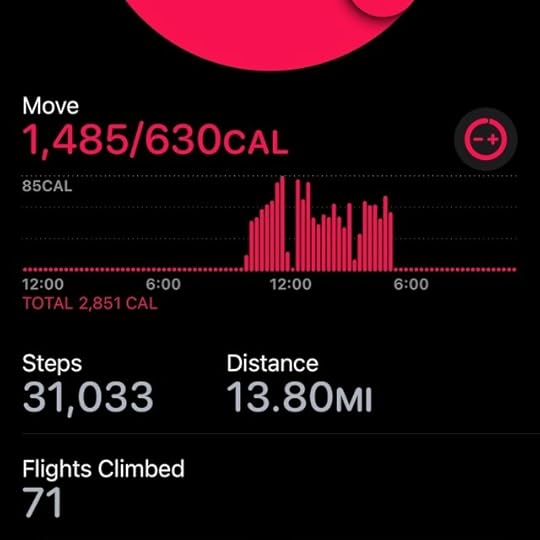
I expected to take tons of photos and record lots of audio, but I only took a dozen or so of the former and one of the latter, this bit of a wind chime as we we approached West Portal. On the one hand, I can be disappointed when a sound can’t easily be isolated from apparent noise; on the other hand, I found myself reflecting on the combination of all the sounds, and how that correlated with the numerous connections (geographic, cultural, environmental) revealed over the course of the walk.
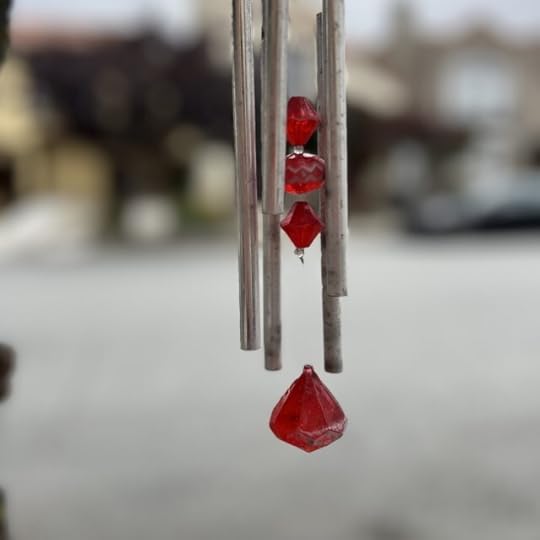
More on the trails at crosstowntrail.org.
*stopped briefly for lunch in West Portal and tea in Alamo Square
July 6, 2025
On Repeat: Jaw, Hyperglyph, Orcutt/Corsano
On Sundays I try to at least quickly note some of my favorite listening from the week prior — things I would later regret having not written about in more depth, so better to share here briefly than not at all.
▰ HuiChun Yang performing live with a jaw harp, which she’s processing in real time.
▰ Chicago Underground Duo is Chad Taylor and Rob Mazurek, and they have their first album in over a decade due out, Hyperglyph. One track, “Click Song,” is already out. To me it sounds like if the children of the Master Musicians of Jajouka had enrolled at Northwestern University or the University of Chicago and hooked up with the local music scene.
▰ The guitarist Bill Orcutt and drummer Chris Corsano, a nearly 18-minute live recording. On the surface it’s wild, but if you give yourself over to it, it’s quite meditative:
July 5, 2025
Scratch Pad: Din, 40, 耳鸣
At the end of each week, I usually collate a lightly edited collection of recent comments I’ve made on social media, which I think of as my public scratch pad. I find knowing I’ll revisit my posts to be a positive and mellowing influence on my social media activity. I mostly hang out on Mastodon (at post.lurk.org/@disquiet), and I’m also trying out a few others. And I generally take weekends off social media.
▰ Gonna start a noise band called Din DeLillo.
(I got some fun responses to this, most mentioning White Noise. My favorite suggested a producer: Thomas Punch-in.)
▰ I managed to crash the dictionary on my MacBook. That’s a first.
(I was searching for whether we spell it “labeled” or “labelled” in the U.S., and it’s the former.)
▰ Three men sitting silently in a barbershop while Rod Stewart sings “Hot Legs” on the stereo
▰ I had a dream, before Bill Viola died, that he’d film an Earth music video focused just on drummer Adrienne Davies
▰ Ah, summer in San Francisco.
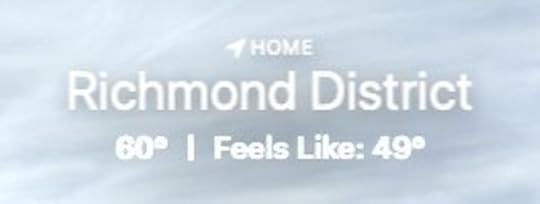
In case it’s unclear, the temperature is 60º Fahrenheit. And it felt a lot colder.
▰ I now recognize my best use of a large second screen (that is, when I’m at my desk) is not as a larger version of my laptop screen, but as a digital cork board for various smaller windows: notes, audio player, messages apps, browser windows, etc. I just keep working on my laptop as usual, and the large screen plays a supporting role.
▰ Either a funny choice or a modern absurdity, this is a captcha I had to do when trying to fill out some forms on the DMV (Department of Motor Vehicles) website to renew my driver’s license:

▰ It occurs to me there isn’t a day of the week I don’t spend with the Disquiet Junto. From Thursday to Monday there are new tracks arriving. Tuesday is for listening to the final tracks that appeared overnight. Wednesday is prepping the next project. And then it begins all over again.
▰ I finished reading one novel this week, Sandro Veronesi’s The Hummingbird. I enjoyed how it jumped around in time and employed lots of different formats, including email and letters. I posted, earlier this week, a list of the dozen novels I finished reading during the first half of 2025.
▰ And this week in #dronescrolling — i.e., stuff other people posted: Woshibai, based in Shanghai, China, is one of my favorite comics artists working today. Check out this piece, posted on Threads, about tinnitus. You can easily translate the brief captions using Google Translate or a similar service. I’d reproduce the rough English translations here, but I’d say part of the pleasure for me of reading Woshibai’s comics is the time that it takes for me to copy and paste. In an age of constant and immediate media, I’ve come to appreciate the pace required to select an individual caption at a time, paste it into a browser window, and wait to see what is revealed. Much of Woshibai’s work feels fractured and elliptical. This one, titled “Tinnitus” (“耳鸣”), is especially tight, and it closes expertly. ▰ Mode Exchange is new to me. It’s a venue (or maybe a promoter?) of sound work in Tokyo. The aesthetic and line-up are aces. Check it at instagram.com/mode.exchange. ▰ I love how a local used record store, Noise, one of two that are walking distance from where I live, fills its Instagram with photos of people and the vinyl albums they’ve purchased. This occurs on Instagram. Here’s a recent set of 10 such images.
July 4, 2025
Science Fiction Authors Under 40
This week I asked the following question on Bluesky, Facebook, Instagram, Threads, and Mastodon: Who are your favorite science fiction novelists under the age of 40 who have had at least two novels published? For future reference, this would be as of July 2, 2025.
As a kid I naturally read mostly people who were considerably older than myself. However, many of their best books were published when they were under 40. Isaac Asimov had numerous novels out before he turned 40, including The Caves of Steel, Pebble in the Sky, and Foundation. Ursula K. Le Guin, born 1929, saw A Wizard of Earthsea published the year before she turned 40. Robert Heinlein would not have made it onto a list such as this at any point, or maybe just for a few months, because his first novel, Rocket Ship Galileo, came out the year he turned 40, 1947. (I had forgotten how much older he was than Asimov. When I was a kid, they seemed like peers.)
In the years after I graduated from college, I was reading novelists who were closer to me in age. Many remain favorites to this day who were well under 40 when I was getting into them (Neal Stephenson: Zodiac, Snow Crash, The Diamond Age; William Gibson: Neuromancer, Count Zero; Jonathan Lethem: Gun, with Occasional Music; Amnesia Moon; As She Climbed Across the Table; Girl in Landscape; Motherless Brooklyn; The Fortress of Solitude — jeepers).
Earlier this year, I re-read Stephenson’s Cryptonomicon, which was published in 1999, the year he turned 40. For dessert, as it were, I re-read “Mother Earth Mother Board,” the fantastic non-fiction article he wrote for the magazine Wired in 1996. That got me wondering: if Wired were to assign an author under 40 years of age an article like that — a globe-trotting endeavor in hacker journalism amounting to well over 40,000 words — who would write it, and what would the topic be?
And that thinking helped me recognize that while I’ve read many science fiction authors while they were under 40 but no longer are under 40, as well as many science fiction novels, albeit after the fact, written by authors when they were under 40, I’m not at this moment reading a lot of science fiction authors who are currently under 40 (excluding comics, manga, graphic novels, etc.).
Which is why I asked. And various people helpfully responded with the following:
Marie-Helene Bertino*
Gautam Bhatia
Pierce Brown
S. A. Chakraborty
Alix E. Harrow
C. A. Higgins
S. L. Huang**
R. F. Kuang***
Masande Ntshanga
Suyi Davies Okungbowa
Tochi Onyebuchi****
Eliot Peper*****
Grant Price
V. E. Schwab
Emily Tesh
*I’ve started Beautyland, and I’m digging it.
**I’ve read Zero Sum Game.
***I’ve read Babel.
****I read a third of Goliath and should get back to it.
*****I’ve got a copy of Breach waiting for me.
Wrist Radio
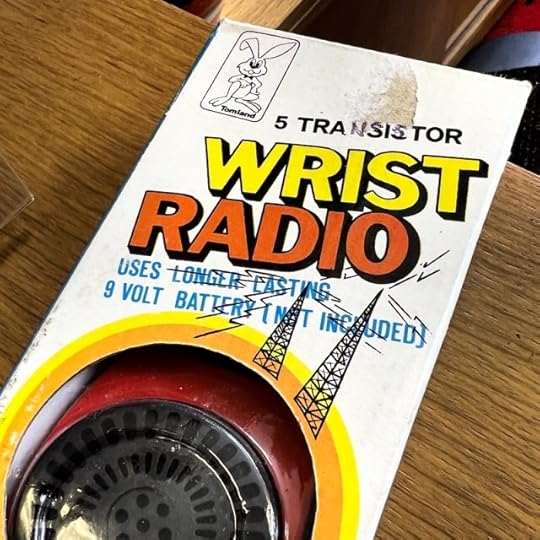
The latest in wearables features no fewer than five transistors.
July 3, 2025
Disquiet Junto Project 0705: Book Start
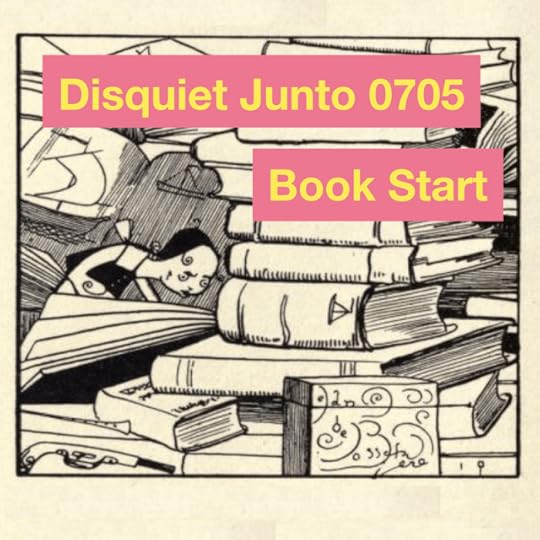
Each Thursday in the Disquiet Junto music community, a new compositional challenge is set before the group’s members, who then have five days to record and upload a track in response to the project instructions.
Membership in the Junto is open: just join and participate. (A SoundCloud account is helpful but not required.) There’s no pressure to do every project. The Junto is weekly so that you know it’s there, every Thursday through Monday, when your time and interest align.
Tracks are added to the SoundCloud playlist for the duration of the project. Additional (non-SoundCloud) tracks also generally appear in the lllllll.co discussion thread.
Disquiet Junto Project 0705: Book Start
The Assignment: Let the beginning of a book help you begin a new piece of music.
This week’s project was proposed by Neil Stringfellow.
Step 1: Choose a favorite book, or simply choose one at random.
Step 2: Read — preferably aloud — the first sentence in the book’s text.
Step 3: Make music that somehow reflects the line you read in Step 2.
Tasks Upon Completion:
Label: Include “disquiet0705” (no spaces/quotes) in the name of your track.
Upload: Post your track to a public account (SoundCloud preferred but by no means required). It’s best to focus on one track, but if you post more than one, clarify which is the “main” rendition.
Share: Post your track and a description/explanation at https://llllllll.co/t/disquiet-junto-project-0705-book-start/
Discuss: Listen to and comment on the other tracks.
Additional Details:
Length: The length is up to you. Is it a novel or a short story?
Deadline: Monday, July 7, 2025, 11:59pm (that is: just before midnight) wherever you are.
About: https://disquiet.com/junto/
Newsletter: https://juntoletter.disquiet.com/
License: It’s preferred (but not required) to set your track as downloadable and allowing for attributed remixing (i.e., an attribution Creative Commons license).
Please Include When Posting Your Track:
More on the 705th weekly Disquiet Junto project, Book Start — The Assignment: Let the beginning of a book help you begin a new piece of music — at https://disquiet.com/0705/. This week’s project was proposed by Neil Stringfellow.
July 2, 2025
Beaterator 2025
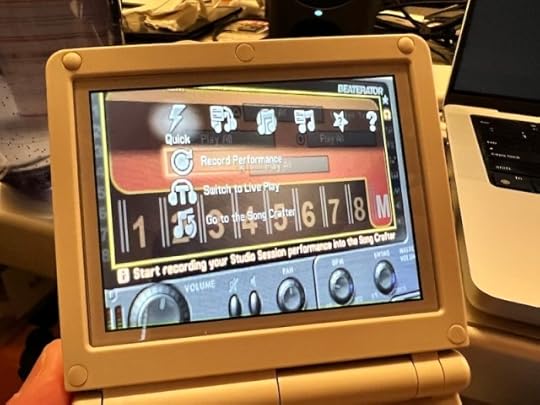
Confirmed, per a suggestion by Peter Kirn, that you can, indeed, run Timbaland’s Beaterator game, originally developed for the PlayStation Portable, on a modern portable “retro” game console like the Anbernic SP, shown here. Shortly after its PSP debut, in 2009, the game also appeared on the iPhone.



